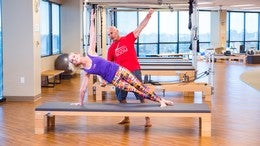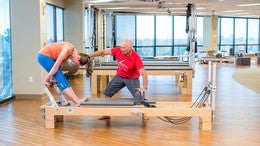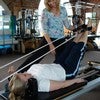Tutorial #3136
Balance Control Front Deconstructed
Description
About This Video
Transcript
Read Full Transcript
Welcome to BASI Academy, fully furnished with BASI Systems equipment. I'm so proud to have Pilates Anytime here at the academy. I want to thank Kara, who is soon to be BASI faculty, for coming in to assist me with this exercise and demonstrate it. We going to do the balance control front, so often done, and yet seldom done with the kind of control, alignment that we at BASI like to see, that we strive for, that we put in hours, years of work to achieve. Now remember the exercise starts from the setup.
The setup is 90% of the exercise. The movement is simply layered on top of the setup. So Kara, let's stand on the reformer. We also think of safety first and foremost. So Kara puts one foot on the bar, she pushes out, and she plantar flexes this foot.
Can you do any more plantar? That's it. Drop the pelvis a little lower, and bring the hands under the, the wrists under the shoulders. She is already immersed in the exercise, so that when she lifts the other leg, there's no change. The body is already prepared.
She is well within the exercise already. Now think of a little more back extension here. We don't want the rounding of that back. We wanna think all the time of this elongation. As, drop the pelvis slightly, perfect.
Push the arms forward with no movement, elevation of the scapulae. The scapulae rotate, but do not elevate. And, reaching forward, and back. And, reaching forward. And what determines how far you go, is how stable you can keep the scapulae.
We do not want elevation. We can have outward rotation, but not elevation. She'll do one more. Notice she's got the powerhouse and the powerhouse of the upper girdle working. She now puts one foot down, brings the carriage in, puts the other foot down, and slowly steps off.
The exercise only ends at this point. Now I'm just going to demonstrate to you where I want you to aspire to reach. So again, I step up. You push out with one leg. You stablilize.
You've got that plantar flexion. You lift the other into position. I always think of my back extensors working. And then from there, you're suspended, so that you can reach out, and slowly pull it back in. But I like the way that you didn't go beyond your comfort.
You can reach out. The scapulae are in place. And bring it back to there. Slowly put the foot down. Bring the carriage in.
Step down, and then step down. So there's always that sense of control, of quiet in the body, calm. I have an agreement with myself. The more challenging the exercise, the calmer and more quiet I need to be within myself. That is beautiful.
I want to take it onto the mat, to work on a preparation how to get to the point where you are very unstable. By the way, Kara and I, we were on one spring. We wanted to be light, so that the stability, the support, comes from your own body. So I don't recommend more than one spring. If anything, one and a very light spring, but you don't want it heavy.
It shouldn't be a muscling-it type of exercise. Let's move on to the mat. So Kara, let's start on the mat with the front support exercise. That prepares the upper girdle to take so much work. So if you could kneel in a quadruped position.
Notice even in this position, how Kara is working on the stability of the scapulae. So seldom do I see a push up, or this plank position, being done with the kind of scapular stabilization that we need for then taking it onto the reformer. Okay, Kara, from this position, take one leg back. That's equivalent to putting that leg on the foot bar. She takes the other leg back.
Nothing happened in her body. Exactly the same as we did on the reformer. Lower the pelvis slightly. Look at that beautiful line she has here. The scapulae are absolutely stable.
And bring in one knee. And she reaches that leg back. And bring the other leg in. I will say, that if you want to just help yourself a little, you can take a little rest there, with that knee on the ground. And then taking it back.
Keeping again, your two powerhouses here. You've got the powerhouse. Drop the pelvis just a little. This is your powerhouse. And the powerhouse of the upper girdle.
And push back, and... Yes. Scapulae are still, keep the pelvis low. There's always that tendency for the pelvis to lift up. Or, sometimes to sink.
Neither are good. We wanna keep the pelvis aligned with the body. Good. Holding this position here, holding that, I want you to bend the elbows just five degrees. Bend the elbows, so you're doing a push up, a tricep push up, and come up.
So let's keep the scapulae even more stable. And bend, and up. Good. Bring one knee in, the other knee in. We're going to now do three more push ups.
Take the hands just a little forward. And your knees a little back. There, so there's a little more space. From here, again, tricep push up, just five degrees, to challenge those scapulae. So I like to think of the scapulae as stable, and all we're doing is lowering the body.
We're, it's like we're... This is the exercise, here. And we simply lower the body, using those triceps, and come up. Think of the muscle that controls...that abduction of the scapulae, your serratus anterior. Think of it holding the scapula, just particularly your right one, Kara.
And up. Now hold the stability, as we go one more time back to the plank position, that front support position. And now, she is ready to move onto the reformer. This takes preparation. Thank you.
Bring the knee down. This takes preparation. It's not a matter of simply jumping onto the reformer because you can do a push up. This one is done more by men, badly. That wasn't very well-said.
It is done badly more by men. Meaning, men come out of the womb doing a push up. So they think we can just hop up onto that reformer. It's a push up. What's the big deal?
There is a big deal. It's not good. And we are not giving the respect to that exercise that it deserves. So the scapulae move all over the place, the scapulae adduct, the scapulae elevate, we sagging. Please, this is an advanced exercise.
It needs, you need to build up to that exercise to the control that you need. That looked really good. The right scapula is the one that we're gonna work on. I know we gonna be together for years and years, so we gonna work on that right scapula. So that she keeps those scapulae very stable and level as she either goes into a tricep or pec push up, or into the balance control front.
Thank you so much.
Comments
You need to be a subscriber to post a comment.
Please Log In or Create an Account to start your free trial.























